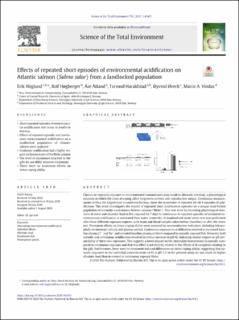| dc.description.abstract | Chronic or repeated exposure to environmental contaminants may result in allostatic overload, a physiological situation in which the costs of coping affect long-term survival and reproductive output. Continuous measurements in Otra, the largest river in southern Norway, show the occurrence of repeated 24–48 h episodes of acidification. This work investigates the impact of repeated short acidification episodes on a unique land-locked population of normally anadromous Atlantic salmon (“Bleke”). This was done by recording physiological measures of stress and allostatic load in fish exposed for 7 days to continuous or repeated episodes of simulated environmental acidification or untreated Otra water (controls). A standardized acute stress test was performed after these different exposure regimes, with brain and blood samples taken before (baseline) or after the stress test. Treatment effects on stress coping ability were assessed by neuroendocrine indicators, including telencephalic serotonergic activity and plasma cortisol. Continuous exposure to acidification resulted in increased baseline plasma Cl− and Na+ and elevated baseline plasma cortisol compared to episodic exposed fish. However, both episodic and continuous acidification resulted in similar increase in gill Al, indicating similar impact on gill permeability of these two exposures. This suggests a lower impact on the electrolyte homeostasis in episodic compared to continuous exposure and that this effect not is directly related to the effects of Al complexes binding to the gills. Furthermore, there were no treatment induced differences on stress coping ability, suggesting that episodic exposure to the sublethal concentrations of Al in pH 5.5 in the present study do not result in higher allostatic load than in control or continuous exposed Bleke. | |
